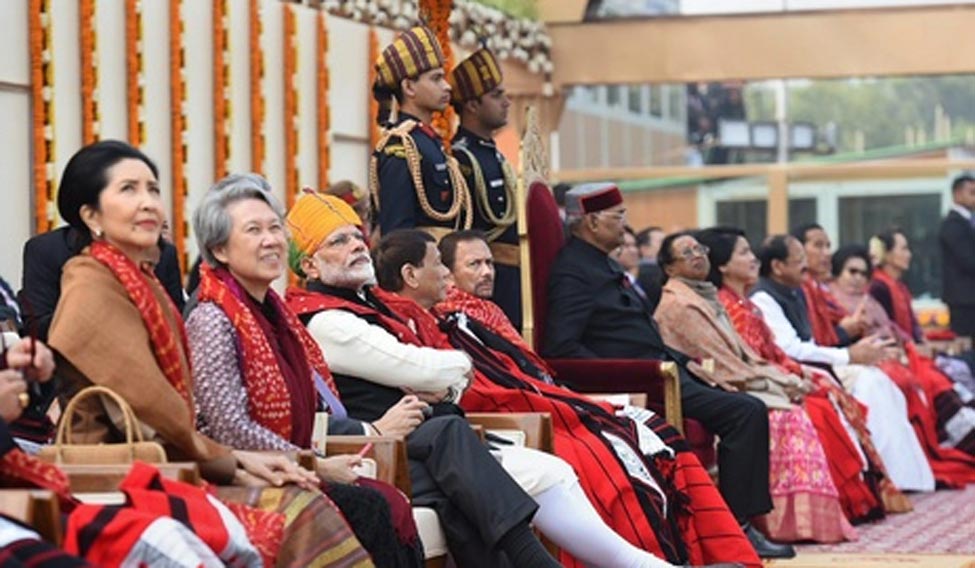India's Republic Day has not always been a one-guest affair.
In 1956, the British chancellor of the exchequer and the chief justice of Japan were joint chief guests; in 1968, Soviet leader Alexei Kosygin and Yugoslavia's Marshal Tito were hosted, and in 1974, Tito arrived again along with Sri Lankan prime minister Sirimao Bandaranaike. But never did the republic score a perfect 10-member guest list.
Narendra Modi—who had got the SAARC rulers to stand in attendance at his swearing-in in 2014, and got the US president for the first time as the Republic Day chief guest in 2015—has now pulled off another camera moment summit. He got 10 ASEAN leaders to fly in as chief guests for President Ram Nath Kovind's first Republic Day.
Though he had no vision, road map or sea map to offer them that could rival Chinese President Xi Jinping's Belt and Road, Modi had more than the military marching contingents, the leopard skin-clad music bands, the Mirages and the Mi-17 helicopters to show off before them.
In the two-hour-long informal chat at the 'retreat' in the Mughal Gardens on the eve of Republic Day, Modi laid out before the ASEAN leaders his ideas on “maritime cooperation and security” in the Indo-Pacific region.
Indeed, the term 'Indo-Pacific' wasn't used, nor was there any mention of China by name, but it was clear that the 10 leaders were brought in to explore whether they could at least compare notes with one another on how the rise of China could affect them all.
Indeed, there was no common approach identified; on the contrary, each had his or her own national approach towards China's rise. All of them had attended, or sent their representatives to attend, Jinping's Belt and Road jamboree last year. And Jinping had shown that he brooked no abstentions. Soon after the conclusion of the summit, he had sent a military road-building party to his border in the Doklam area with India and Bhutan, the only two neighbours of China that were absent.
Yet if the ten arrived, that showed that they too are not very comfortable with such aggressive diplomacy from China, which they may have to reckon with in future in their maritime neighbourhood.
Already, China, once confined to the continent, is showing signs of its maritime muscle in the South China Sea, claiming common navigation channels and oil- and mineral-rich islands as its own.
The only power that has a decent maritime presence and can acquire the required muscle to keep the seas of the east open is India. After all, the British had ruled the entire eastern seas by maintaining a strong maritime presence in India and a garrison in Singapore.
While the guests were all concerned about peace and security in the world's eastern waters, they too did not seem to have a common approach on how to deal with China. While Vietnam, Brunei and Malaysia, which had maritime disputes or issues with China, seemed to advocate a gang-up approach, most other ASEAN states seemed to be in favour of a more subdued policy in the interest of peace and security in the seas.
Modi stressed on a “rules-based order for the seas,” “respect for international law, notably UNCLOS” and “freedom of navigation in our shared maritime domain,” which was an indirect reference to China's aggressive maritime behaviour.
Though India has no maritime dispute with China anywhere, it is hamstrung by the fact that close to half of its oceanic trade passes through the troubled South China Sea and it just lacks the maritime power to reach out there. On the other hand, India has the power to patrol and police the Indian Ocean through which nearly a third of China's ocean trade passes.
In the end, the joint declaration merely said that the ASEAN 10 and India would strive to strengthen maritime cooperation through existing relevant mechanisms including the Expanded ASEAN Maritime Forum (EAMF) and address common challenges on maritime issues.
There were also discussions on land connectivity between India and ASEAN. They resolved to complete the India-Myanmar-Thailand Trilateral Highway Project as early as possible, and hopefully stretch it to Cambodia, Laos and Vietnam.
Finally, the ten plus one agreed to set up a mechanism on maritime cooperation to counter the common 'traditional' and 'non-traditional' challenges they face.
Much stress was put on the centuries-old cultural ties between India and the southeast Asians. Many interpreted this as an attempt at promotion of the Modi regime's pan-Hindutva agenda, since most of these cultural linkages had taken place in the so-called early medieval Hindu period when Buddhist teachers and Ramayana stories travelled out from India.
The real intent, according to senior diplomats, is more realistic. “The Chinese have been aggressive on cultural diplomacy of late, stressing on the commonality of culture, ethnicity, and even religion between the southeast Asians and China,” said an Indian diplomat.
“Most of these countries are either Buddhist majority, or have large Buddhist populations. China too has a large Buddhist population as also a strong Buddhist tradition. They do harp on these to build relations and create a feeling of traditional fraternity with these countries and their peoples. So we too ought to stress on our own Buddhist and Hindu traditions that we share with these people.”






